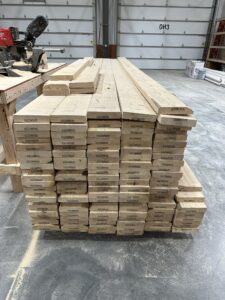This post focuses on the most misunderstood law of structural physics that all too frequently results in very costly remediation and occasionally, can cause complete collapse. The structural system here is the simple post and beam system that occurs in nearly every building type whether you’re building with wood, steel, concrete or any other structural material.
Let me set the stage here. You’re out on a jobsite of a new construction wood framed two story office building that has a structural steel I-beam that carries the load of the main level floor deck joists along with the load from a second level floor deck through a continuous bearing party wall on the main level. The plans call out for a w10x45 steel I-beam in the main level floor deck to carry that load. The owner shows up and tells you that they leased two of the units together, and now we have to create a 12′ opening in that bearing party wall so the spaces can be connected. The contractor calls the lumber supplier and asks generally what size beam would be necessary to carry a second floor deck load and an 12′ span. The beam is sized and the project continues moving forward.
Does anyone see any problems with what was just described? Most framer’s would say “that happens all the time”. It does happen all the time and there is a major concern here because by making that change, there is a better than 50% chance that you are now overstressing the steel I-beam below that was designed to carry the uniform load from the upper and main level floors together. How can this be if the resulting load to the foundation hasn’t changed?
The answer is in the load path. Different load paths have different effects on the physical structure of the beams in these buildings. I could teach an entire semester on this topic, but for the sake of this post, we will boil it down into the simplest example: A simply supported beam carrying a uniform load (like a uniform layout of floor joists for example). We calculate the load on this beam in terms of a linear loading of pounds per linear foot. Once you have this calculation, you can consult any number of tables or charts and size the appropriate beam. However, if you have a point load from a load bearing column, you have to reduce that load into an equivalent uniform load so you can have an apples-to-apples comparison and use the same charts that you have for uniform loading.
So, what is the difference between the point load and the uniform load? The simple answer is:a lot! Without going into the engineering complexities of moments of inertia, section moduli, and even bending moments, suffice it to say that a point load is a lot harder on a beam than a uniform load. This is why if you ever find yourself on thin ice, you should lay flat out and distribute your weight evenly rather than standing (and breaking through).
Imagine a 10′ length of 2×4 supported at each end by cinderblocks. If I hang a 1 pound bag of sand at each 1 foot interval, I would have 9 pounds of sand hanging uniformly from this board in one pound increments and it would bend a bit (I’m using 9 pounds because the pound at the cinderblocks doesn’t really count). Now, if I were to take all 9 pounds and hang them from the middle of the board, what do you suppose would happen? I encourage you to try it, but for those of you who just can’t wait that long, I’ll tell you: The board will deflect considerably more. In fact, it will deflect as if you had 2 pound sacks distributed evenly at 1 foot intervals. In simpler terms: double the effective load.
The physics behind this phenomenon are very extensive and there are a great many number of variables involved. The point here is that it is important to understand that the way you design the structure in a building depends very heavily on how that structure is loaded. This is one of the many direct ways we are able to value engineer projects as we design the architecture for them. It is also why remodel projects can be so difficult because the forensic engineering required to determine the existing load paths and how the new paths will affect them can easily eclipse the time it takes to actually prepare the drawings themselves.
And most importantly, it is why you should never make assumptions in the field about how to change a load path for those inevitable on-site changes. Always involve the architect or engineer and if they can’t feasibly visit the jobsite in time, explain everything that you’re doing in detail from the top all the way to the bottom so they can assess every part of the system. The consequences of those assumptions will almost always be far more costly and no one wants to be on that kind of thin ice.











1 thought on “Walking on Thin Ice With Structural Changes”
I just found your site/blog. Excellent stuff! I’m an electrical engineer at NASA who designed then built, over 2 years of weekends with friends and my father (now retired mechanical engineer), my house. I’m now starting on designing a vacation home. Even though I’m electrical, some of my favorite classes were statics, dynamics and thermodynamics (HVAC from the engineer’s perspective). I really enjoy reading these. Total engineer nerd stuff. Love it!
Steve
Comments are closed.